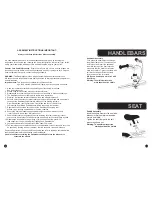
EN
39
2.
Safety
2.1 General safety
DANGER
Inadequate protective equipment can cause injuries!
Effective protective cycling equipment helps increase your personal safety.
• Always wear a helmet.
• Always wear highly visible and reflective clothing.
DANGER
Improperly installed components can cause serious crashes!
Any improperly installed components could loosen during the ride!
• Always follow the installation instructions included in this manual.
• If in doubt, please consult the ROSE service or a qualified bicycle mechanic.
DANGER
Risk of accident due to sudden total failure of pre-damaged components!
A fall or unforeseeable manoeuvres can cause damages to components of your bike. Even though you might not immedi-
ately notice those damages, it is always possible that pre-damaged components deform or break while riding.
• Regularly check your components for damages.
• Components that are subject to high stress must be regularly replaced and checked by a qualified bicycle mechanic.
2.2 Carrying children on a bike
DANGER
Risk of injury when carrying kids in a bike seat or bike trailer!
Carrying kids in a bike seat or bike trailer inappropriately may lead to accidents with a high injury potential.
• Please note the information in chapter “6. Cycling with kids”.
• Never carry a child in a bike seat or bike trailer if not all of the conditions in chapter “6. Cycling with kids” are
complied with.
2.3 Safe use of the brakes
DANGER
Risk of accident due to reduced braking performance caused by brake pads that are not broken in!
Disc brakes can only achieve full braking power when the brake pads are broken in. Choose a place away from public
roads to break in the pads.
• Brake 20 to 30 times with the front or rear brake from a speed of 30 km/h down to 5 km/h and repeat the process
for the second brake. You should brake as hard as possible without locking one of the wheels.
• Please also see the brake manufacturer’s instructions for more information (see enclosed manual).
















































